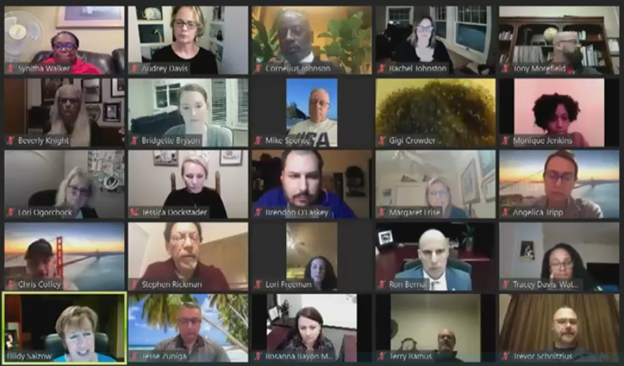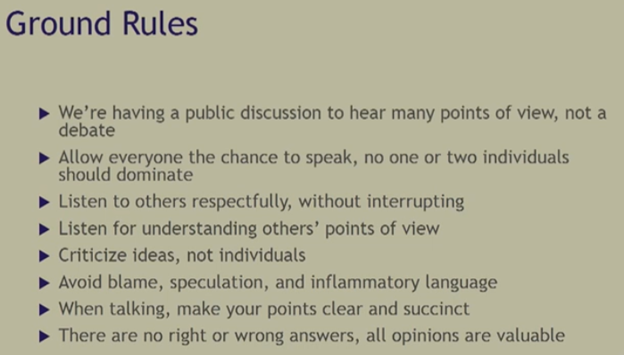Discussion on Antioch Police oversight, transparency, accountability shows broad support for department, but room for improvement

Some of the participants in and consultants for Antioch’s first of three Bridging the Gap dialogues held on Tuesday, Jan. 19, 2021 during the opening session. Councilwoman Lori Ogorchock, City Manager Ron Bernal and Assistant City Manager Rosanna Bayon Moore are also pictured. Video screenshot.
Overwhelming support for body worn cameras
By Allen Payton
The first of three “Bridging the Gap” discussions on Antioch police, community and race relations held Tuesday night, appeared to show there is no gap that needs to be bridged between the community and police department. The first discussion, on the topic of Police Oversight, Transparency & Accountability, offered broad support for both Chief Brooks and Antioch police in general from the 75 members of the public who participated and broke into five groups for their discussions. (View video of first meeting, here)
However, participants believe there is room for some improvement in the areas of transparency and accountability, with the use of body worn cameras, and better communication, as well as some additional citizen oversight, just not “overreach”.
The format of the forums was finally, fully explained to the public with the City only broadcasting the opening and report-out, closing session on the city’s website and on Comcast Channel 24. But not the five breakout sessions. Plus, the council members did not and will not participate in the discussions due to the Brown Act state open meeting law. They could just watch and listen.
Hildy Saizow of the consulting company CAN, hired to facilitate the discussions, opened the meeting and explained the format. She then introduced Mary O’Connor, retired Assistant Chief of the Tampa, Florida Police Department, and currently an instructor with the FBI-LEED, Law Enforcement Executive Development Association, according to her LinkedIn profile.
O’Connor spoke of the various ways that cities provide oversight of their police departments, both internal and external to “ensure the complaint process is available to anyone.”
“Some oversight committees have investigative authority,” she shared. “Some have subpoena powers.”
O’Connor then shared there are concerns that oversight committees are “way above and beyond what cities can do and afford.”
“Prosecution rates increase as a result of body-worn cameras,” she stated.
Saizow then shared the ground rules for the break-out sessions.

Then those members of the public who weren’t one of the 75 who either live or work in Antioch and randomly selected to participate in the breakout sessions were shown the following screen:

Earlier Tuesday, Mayor Lamar Thorpe, Assistant City Manager Rosanna Bayon Moore, and Public Information Officer Rolando Bonilla were asked for a list of the names of the 75 participants for each of the three forums, and when and where the reports from the break-out sessions will be made available. A response is expected sometime on Wednesday.
When the group returned for the public to watch, O’Connor spoke about her break-out session.
“The majority of our group believes the Antioch Police Department is transparent,” she said. “They know of teams that go out to the community and meet with groups. They believe the police department does a good job on promoting their events” on social media.
“Our group felt, based on their breadth of knowledge, that some accountability was necessary,” O’Connor stated. “They did cite some officers who have been in the news that they’ve heard about. There was some positive, some negatives. Generally from an accountability the citizens would like to know more about what happens in the department.”
“Our group was overwhelmingly in favor of some oversight, but were concerned about costs and where they would come from,” she said. “They supported body-worn cameras over civilian oversight.”
“As far as civilian oversight, they said they would be willing to be a part of that,” O’Connor stated. “They said there should be civilian oversight but not overreach.”
She shared that one participant in her group said, “the bodyworn cameras are long overdue,” and another said, “we can’t afford not to have bodyworn cameras.”
There was “overwhelming support for bodyworn cameras and dashboard cameras,” O’Connor pointed out.
The city needs to “provide more information to the people who come to these sessions about bodyworn cameras,” she added. “There is a lot of information out there how bodyworn cameras can have negative impact on the community.”
“There was a large part of our group that has done the Citizen’s Academy and done ride-alongs,” O’Connor concluded. “I think that pretty much wraps up our report.”
Rachel Johnston, a colleague of Saizow shared about the results from her breakout session.
“There was a lot of support for the Antioch Police Department and Police Chief Brooks,” she said. “Regarding transparency, there’s not a lot of understanding of what transparency is. But overall there is agreement that there’s always room for improvement. APD could engage in these technologies, bodyworn cameras and dashboard cameras.”
Johnston spoke of “the overlap of accountability and transparency. How can APD be accountable if they’re not being transparent?” was a question from her group. “People weren’t quite sure what the outcomes of certain incidents.”
“As for police oversight, there’s a lot of support for the police department,” Johnston shared. There was mention that “community members aren’t entitled to known everything and that civilians wouldn’t be effective, because police require a lot of training.”
She also said the members of her group said communication with the police department could be improved.
Stephen Hickman, another colleague of Saizow, shared from his group:
“Generally there was an issue raised about transparency in hiring. Antioch has come a long way with transparency,” he said. “The police and community need to meet halfway to bridge that gap.”
“On accountability there was a feeling among some that there isn’t good accountability and they cited certain cases” and “a general concern about not having information,” Hickman continued.
Regarding “bodyworn cameras, there seemed to be general agreement, but once again, wanting more information,” he stated.
On “civilian oversight, they thought that was a good idea. There was some concern about volunteers being overwhelmed. There were some of the suggestions for making things better and for building trust…making better use of social media.”
Monique Jenkins, another colleague of Saizow’s, shared about her group’s interactions on the subject matter.
“Most felt good about transparency from Chief Brooks but that there could be improvement,” she said. “Members shared support for oversight but, there was dissent kind of to what point.”
“Others wanted to start from scratch and have a group with more power,” Jenkins stated.
“On building trust, my folks felt there needed to be more community outreach in non-policing situations,” she shared.
Saizow then reported out on her group.
“The first point was around transparency. Most people felt the department is fairly transparent,” she stated. “But, they thought if there was more data, or a data dashboard that was available.”
“Most supported bodyworn cameras,” Saizow said.
“While most felt there needed to be more public input, there’s some concern about a police oversight board, because Antioch is too small and there could be overreach. But some kind of oversight.”
There was discussion around police-community engaging, and community partnership,” she said. “Other people felt that police didn’t come and engage in their particular neighborhoods…with higher percentage of poverty and minority residents.”
“Overall there was support for police and none of these changes would change community trust,” Saizow concluded.
“There are two more round tables to be held over the next month,” she stated. Those will be held on Feb. 6th and 18th and will also only allow 75 participants chosen randomly.
Following the meeting Councilman Mike Barbanica said, “I listened to the main sessions, then monitored my breakout session and was impressed with not only the support for the police department in general, but also for Chief Brooks.”
CNA will be sending out a high-level summary of Tuesday night’s meeting and a report at the end of all three which will be shared with participants.
Dialogue 2: Racial Disparities in Policing
Date: Saturday, February 6th
Time: 10:00 – 11:30 am
Discussion will focus on the disparate impact of police practices – such as recruitment and training, and use of force – on communities of color.
Dialogue 3: Police-Community Engagement
Date: Thursday, February 18th
Time: 10:00 – 11:30 am
Discussion will focus on how to improve the ways in which the police interact with young people and vulnerable communities, how police approach crime prevention, and how communities impact policing priorities.
Please check back later for any updates to this report.
the attachments to this post:

Bridging the Gap Breakout session screenshot

Bridging the Gap #1 participants 1-19-21





















